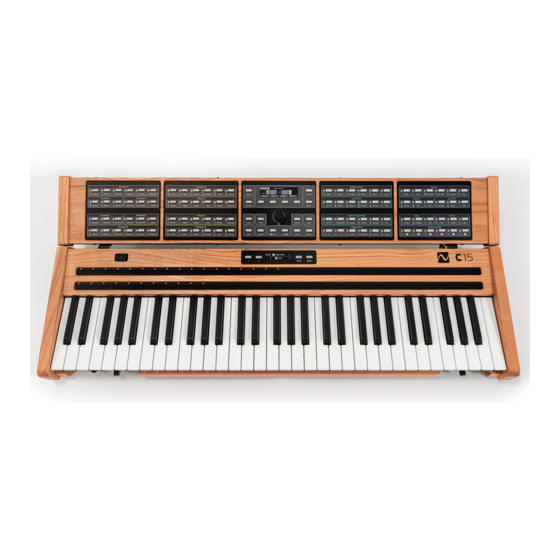Advertisement
Quick Links
Advertisement

Summary of Contents for NONLINEAR LABS C15
- Page 1 User Manual Addendum Update 2020-12...
- Page 2 NONLINEAR LABS GmbH Helmholtzstraße 2-9 E 10587 Berlin Germany www.nonlinear-labs.de info@nonlinear-labs.de Author: Matthias Seeber © NONLINEAR LABS GmbH, 2020, All rights reserved.
- Page 3 Major Parameter Enhancements Enable (On, Off): When on, only one note (containing the defined number of Unison Voices) will be playable, even when multiple keys are pressed. As long as one key stays In the following, major changes and enhancements to parameters are explained. pressed, the release of a key will not stop the envelopes.
-
Page 4: Macro Controls
Part Volume and Tune Macro Controls In Split and Layer Sounds, the Volume and 6 Macro Controls Tuning of a Part can be adjusted by its Part Macro Control E and F have been added. Volume and Part Tune parameters. Smoothing Times of the Macro Controls In former software versions these smoothing times didn’t have an effect. - Page 5 Key Range Enhancements In Split mode the Parts are assigned to two In earlier versions, the C15 only operated on its physical key range of 61 keys (C1 ... C6). separate keyboard ranges. Part I can be The Hardware UI Note Shift was applied as a tuning, whereas Split Point and Fade From...
- Page 6 Overlapping Splitpoints On the Split Sound screen the Split Point In earlier versions, the C15 only provided one Split Point parameter in a Split Sound, is shown in the center. It can be edited determining the inner edges of both fully separated Parts, so no overlap was possible.
- Page 7 → Graphical UI When active, the flow across Parts will be indicated in the Sound screen and tab by labeled “FX” arrows. In the Parameter tab, an icon on the right of the shown key position indicates the linked or unlinked Split Point behavior. Clicking on it will toggle inbetween. Layer Sound Details Key Fades in Layer Sounds In the Sound tab, clicking on the “...”...
- Page 8 → Graphical UI The full level range of Part I spans from the lowest key (C1) to the adjustable “Fade From” key. Here begins the fade-out. Its width is adjustable by the “Fade Range” parameter. The Graphical User Interface provides a Part The full level range of Part II spans from the highest key (C6) to the adjustable “Fade indicator similar to the Screens.
- Page 9 Indicators in a Layer Sound Handling Sound Types (conversion, combination, storing) In Layer Sounds, the “ToFX” parameter is available in the Output Mixer, allowing Creating a Split or Layer Sound the mixed signal to be sent to the Effects section of the other Part. Load the (Single) Preset for the first Part.
- Page 10 When a Dual Preset has been loaded, Soft ࠎ Note that the Load to Part process distinguishes and remembers different Buttons 1 and 4 will now each serve two aspects of selection: purposes. In order to explain each individ- selected Target: referring to the currently loaded Preset’s selected Part ual step of the Load process, the “Direct selected Source: referring to the currently selected Preset Load”...
-
Page 11: Parameter Organization
Storing a Split or Layer Sound as a Preset Parameter Organization A Split or Layer Sound can be stored in the same way as a Single Sound. The C15 Banks can hold Presets of all three types. Split Presets are marked with a “... - Page 12 When a Single Sound (referred to as “Source”) is converted to a Split or Layer Sound On the Graphical User Interface there is a colored frame around the main area including (referred to as “Target”, global Parameters are copied entirely. The Source’s Master Volume an indicator for the selected Part.
-
Page 13: Device Settings
An optional timeout setting has been added in order to prevent possible pixel deteriora- Feedback Mixer - Comb - From x tion in the two displays, which can occur when the C15 is running for longer periods of Crossfades to the Comb Filter signal of the other Part. - Page 14 New, Enhanced or Relocated Parameters New, Enhanced or Relocated Parameters Panel 1 Panel 3 Envelope A Feedback Mixer Attack Decay 1 BP Level Decay 2 Sustain Release A/B x Comb SV Filter E ects Drive Level Envelope C Envelope A Comb Filter Attack Decay 1...
-
Page 15: Connecting Pedals
2. Connect the pedal cable to the C15 at one of the TRS Sockets numbered “Pedal 1...4”. The C15 may already be powered on or off, it does not matter. If on, try to insert the cable quickly into the TRS socket (in less than 1 second). - Page 16 List of Pedal Presets Name / Type Remarks Name / Type Remarks Generic 3-Wire Expression/Damper Pedal, Tip-Active (“Roland” pin-out). 3-Wire Expression Pedal, Tip-Active. Pot, Tip-Active If there is a “min” control, set it fully counter-clockwise. E:Boss EV-30 Set “min” controls to fully counter-clockwise. Continuous If there is a “range”...













Need help?
Do you have a question about the C15 and is the answer not in the manual?
Questions and answers